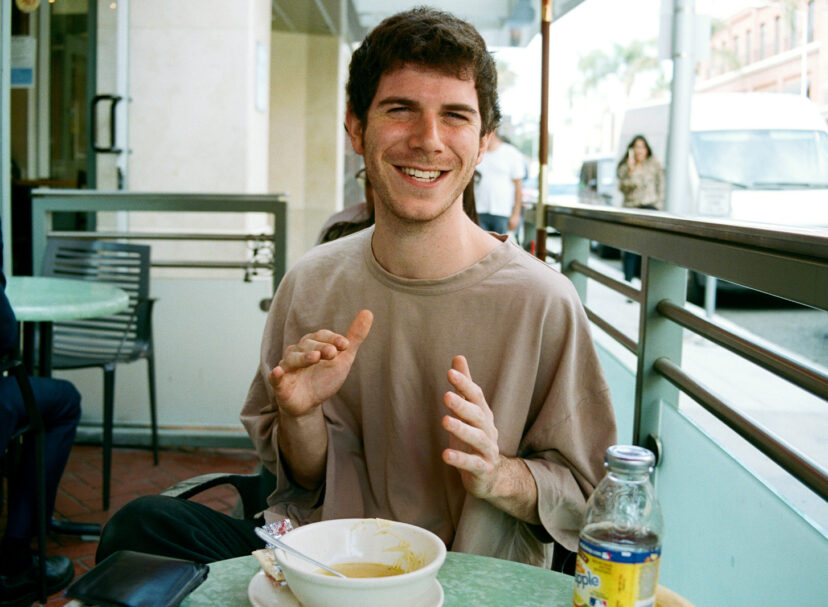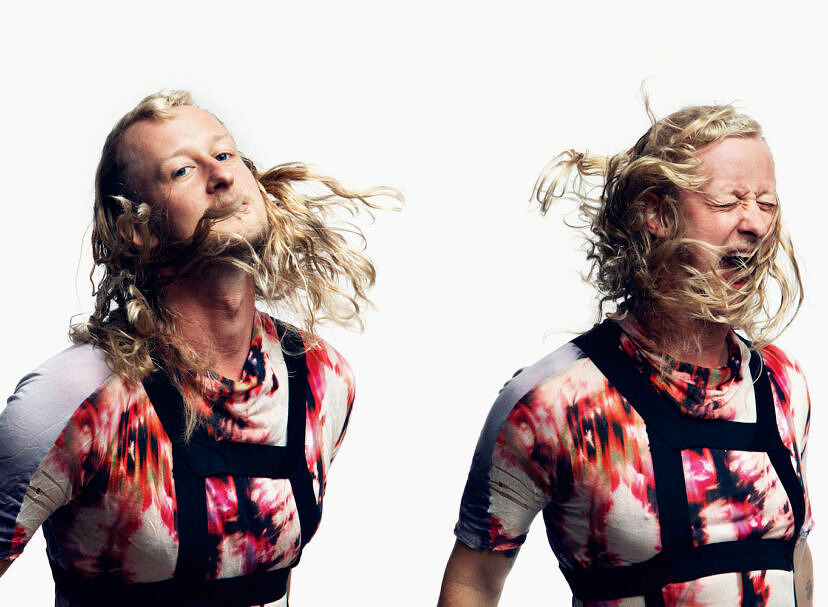Text and Interview: Andy Fenwick
Images Courtesy of Kestrels and Terrorbird Media
At first guitar’s chime, you could be forgiven for hearing Kestrels and thinking My Bloody Valentine, Sugar, or A Place to Bury Strangers. But that’s unfair. Shoegaze-style guitar now ranks as an integral part of rock’s vocabulary, a given in the same way RZA’s open spaces infiltrate all rap production, or the way Aphex Twin’s complex percussion sets the standard for all IDM. Kestrels only use that vocabulary as a tool to build new soundscapes. They otherwise exist as their own thing: an unpredictably catchy, precision-sharp rock unit.
Kestrels do share a songwriting skill that seems to be in the water of their hometown of Halifax, Nova Scotia, with its historically relentless wheel of rock talent (Sloan, Inbreds, Super Friendz). On their third and new self-titled album, they apply a startling level of detail and texture to their studio sound. It’s refreshing to hear a humble record as well-recorded as this, especially in an age where internationally famous artists spend more production cash than the GNP of small countries and still fall short.
Kestrels also benefit from that oft-overlooked secret weapon: talent. Few current dreamwave/noisepop outfits enjoy a drummer like Paul Brown, capable of spinning a wall of fills while maintaining a head-nodding propulsion at any tempo. Bassist Devin Peck is a strumming roar of human propulsion, and Chad Peck declares himself a guitar surgeon of the first order, as well a songwriter able to stuff a tune with hooks. Chad took some time to answer our questions about the new record.

What sounds/studio effects on your great new record aren’t immediately obvious? For instance, do I hear a loop beneath “Are You Alone?” And what’s making that outer-space-y sound at the beginning of “Neko?”
My secret sound approach weapon on this record was using filters. The four I used most frequently were the Moog MIDI MuRF, the Line 6 Filter Pro, an old Electro Harmonix Micro Synthesizer, and a Teese RMC-2 wah. The opening to “Neko” was the Filter Pro synced to the tempo of the track. I used the Obi-Wah patch and strummed my guitar behind the bridge, Sonic Youth style. The filter is attacking random frequencies but doing it at a specific tempo, which gives it that eerie stability. I love that opening. No loops on “Are You Alone,” but our goal on that song was to make the drum sound as rigid as possible – basically simulating a drum machine. That song also showcases another secret weapon: alternate tunings. The rhythm guitar is tuned DADAAD with the AAD strings ringing out on every chord … again, creating a looping, hypnotic effect.
I like how you to build something new with shoegaze elements only as vocabulary; obviously the guitar, but what else? In the drums, I hear precise echoes of Ride’s amazing Laurence Colbert, which few drummers can even begin to pull off these days. Osmosis, or marked influence?
We sometimes call ourselves a shoegaze band, but that’s a bit of a misnomer. We are heavily influenced by that sound and approach to writing and recording, but the songs dictate the approach. You know? We have synergy when we’re in a room together and we pull from our individual histories and interests.
The record sounds amazing, tone-wise. Brad Wood must have helped, but what other special, secret ingredients went into the recording? Did it take long?
It did take a long time, but that’s slightly misleading; it wasn’t like we worked on it five days a week for two years, but we did stretch the recording out over that amount of time. Realistically, we did the drums over the course of 8 days in 2013, and Devin recorded his bass in two marathon sprints. I basically held the proceedings up as I always do. I do think that long gestation period helped the production of the record in the sense that I had freedom to try something, send it to the guys, and then adjust as necessary. On more than one song I would have everything “done,” only to wipe it out and start fresh. Another huge secret ingredient is Alex Gehring, who sings on “Neko” and “Are You Alone?” She pushed those songs over the top. That said, Brad did really make the record something special.
Why the name? Not a common bird; is there a story?
Not a great story–the very earliest shows we played (2007) were billed as Chad & The Brainiacs (silly name – last minute fill in for a band who couldn’t play a show). We covered “Pablo and Andrea” by Yo La Tengo. When the original lineup decided to take it seriously, we chose the name Kestrels. I wish it was more of an engaging tale.
Sonic Unyon has long been great – how’d you get hooked up with them?
Sonic Unyon used to distribute my label, Noyes Records, back in the late 2000s. I used to stop there a lot on the way through Hamilton. They have a cool office in a part of the city that they’ve helped revitalize. When we were making A Ghost History, Mark Milne (co-owner) asked me to send him what we were working on. They invited us to play their Christmas party, and after we got off stage they offered us a record deal. It was a great day. We love those guys and they’ve been great to us.
Is there a video in the works from the new LP?
Yes! “Descent of Their Last End” is being edited as I type this. You will see it shortly.
Sonic Youth had their gear ripped off in 1999, and attributed much of that gear resurfacing, 13 years later, to it all being almost un-sellable due to the modifications they’d made. Have you found most of your stolen stuff, or just some?
About a week after our van was stolen, I saw all of my stuff listed on Kijiji in Montreal. It was a weird time. I tried to get the police involved and they refused to help unless I could prove it was my stuff. Given that I lived two provinces away, that proved difficult. I had a friend of mine meet up with the thief and buy back a cheap power conditioner to prove that the serial numbers matched what was filed on the police report. They did, of course, but the police still baulked–they wanted our organization to set up a sting operation and then call them when we had the thief in our proverbial grip, detaining him until the police showed up. That was unreasonable, and my stuff just disappeared day after day. In one totally remarkable turn of events, my friend was browsing a site called Offset Guitars one day when he noticed someone posting about a new purple J Mascis Jazzmaster he had recently picked up in Montreal for very cheap. I sent the guy a private message with the serial number. The guy confirmed it was in fact the same guitar, and gave it back to me free of charge. I still can’t believe it.
In the 90s, Halifax seemed rife with melody-rich, shoegaze-influenced rock bands. (Sloan, Super Friendz, Thrush Hermit, Jale, the Inbreds). What’s Halifax like now, music-wise, in general?
Halifax has always punched above its weight class in terms of music and it’s no different right now. Lots of bands are releasing records on bigger labels which is always exciting. There’s lots of psych rock. My favorite groups from the city are Soft Spot, Crossed Wires, and Doug Mason.
In 1992 (ok, I’m dating myself), I saw separate live shows by Ride and My Bloody Valentine. They both used crazy-intense lighting, and MBV was punishingly loud. Something you care to do? What’s your live strategy?
Wow, lucky you! We’ve been fortunate enough to play in a few scenarios with great house lights, but typically our approach is to play dream pop songs loudly. There’s some cognitive dissonance in what we do and I’ve always liked that–hearing songs written in major keys played at extreme volumes. Like when I saw My Bloody Valentine in 2013 and they opened with “Sometimes” on the loudest acoustic guitar you could ever imagine–it was jarring in the best way.
We try to do a few other things – I have a pretty sophisticated pedal system that allows for very drastic changes in sound and volume. The natural chorusing of the open tuned guitars is by default a big sound. I’ve tried a lot of amps but I always come back to a 100 watt Marshall, which common knowledge suggests is only appropriate for arenas, but that’s bullshit. Our music requires lots of headroom and you can’t get that in a small combo. Devin plays bass Lou Barlow style – basically the heaviest rhythm guitar. We also have a new member, Jim, who plays guitar and sings, and that’s made things even more enveloping. Melody and volume are the key ingredients every time.

